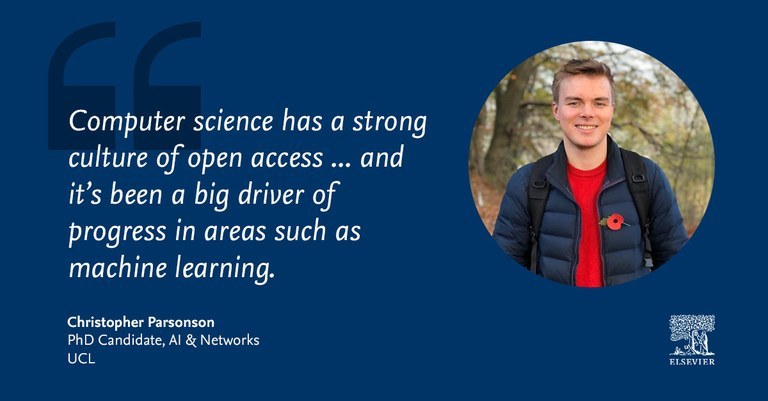
EPSRC funded researcher creates an open access tool to benchmark and investigate data network systems
Christopher Parsonson is a PhD student in AI & Networks on the EPSRC Centre for Doctoral Training in Integrated Photonic and Electronic Systems programme (IPES CDT) at University College London (UCL). As part of a team of researchers lead by Dr Georgios Zervas, Associate Professor of Optical Networked Systems, he produced an open access (OA) framework called TrafPy, which was recently published in the Elsevier journal Optical Switching and Networking.
Chris, Georgios and the team at UCL knew they wanted to publish their work in an open access journal and set out to create an OA tool in an area that would have a massive impact on large-scale artificial intelligence models — and therefore much of modern living.
Chris said:
“We realised there was a lack of open access research around data center networks in general, but in particular the starting point for everything in this area is being able to benchmark different systems. There wasn’t an open access tool for doing that. We knew that creating one was key to accelerating progress, validating new systems, and making everything reproducible.”
As part of the team, Chris led a project to produce an open access framework called TrafPy. Their paper was recently published in the Elsevier journal ‘Optical Switching and Networking’.
Compatible with any simulation, emulation or experimentation environment, TrafPy can be used for standardised benchmarking and for investigating the properties and limitations of network systems. It provides a way to benchmark systems against those developed by other research teams — a crucial element for understanding whether progress is being made.
One of the reasons optical data center networks are so important is that they open the door to many emerging applications, from AI models to genome processing systems. They have the potential to accelerate research in everything from health and technology to entertainment.

The performance of computers is increasing much faster than the rate at which we’re increasing the performance of our data centre networks. Current data centres use electronic switching, have poor scalability, low bandwidth and high latency. They are energy intensive with data centres and data transmission networks each accounting for about 1% of the world’s energy consumption, predicted to rise to 10% to 15% of total energy consumed by 2030. In some cases, more than 50% of that power consumption is from the network performing communication tasks between devices.
Chris said:
“If we want to scale to next generation applications with brain-scale neural network models, which might have 100 trillion parameters, we need next generation data centre networks where the interconnects are all optical. They have much lower latency, take up less space and — because they are passive devices that don’t need cooling — use considerably less power.”
Because data analysis underpins such a vast range of disciplines, applications and technologies Chris finds himself working with people from a diverse range of areas, from physics to electrical engineering and computer science. That broad reach was one of the reasons they were keen to publish open access.
“The more you publish open access, the more likely it is that people in different fields are going to find your work, see the findings you’ve published and apply them in their own research. In data center networking, we haven’t seen much development of open access benchmarks, simulations and systems,” he said.
“Even when research is published, the researchers often hold back from sharing the back-end algorithms or datasets they use, so it’s hard to reproduce the results, to test against old systems and develop new ideas. Our work is to try and redress the balance and tackle some of the shortcomings in open access in data center networking.”
Elsevier has a large audience, a swift yet rigorous review process and high-quality papers that get a lot of traction. The ‘Optical Switching and Networking’ journal caters to next-generation optical data networking centres. This was appealing to Chris and his team as it helped frame their paper and expose their work to the right audience, fast.
Now that the work is published and available, the team hope that TrafPy will be the foundation with which to establish rigorous benchmarks and facilitate the next decade of development in data centre networks. Being completely open-source, anyone can download it and use it any way they wish, which Chris and his team see as the key to accelerating progress.
Chris Parsonson is funded by EPSRC Centre for Doctoral Training in Integrated Photonic and Electronic Systems (IPES CDT) (programme grant EP/L015455/1).
Read the full interview with Chris on Elsevier Connect: link
Published: October 27, 2022
Credits: Original article by Ian Evans, Elsevier © 2022.
Read the journal paper: in Optical Switching and Networking, ‘Traffic generation for benchmarking data centre networks,’ by Christopher W.F. Parsonson, Joshua L. Benjamin, Georgios Zervas in Optical Switching and Networking, Volume 46, 2022, 100695, https://doi.org/10.1016/j.osn.2022.100695
